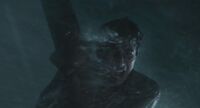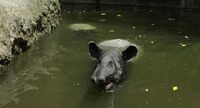-------------------------------------------------- ----------------------------------- I
watched it twice within 48 hours, because I couldn't let go of the doubts in my mind. The first time is the baptism of vision, and the second time is the reading of images.
The first time I appreciate the romance of the first story. That is a beautiful and heartbreaking picture, telling a story like a fantasy.
The second review is the cruelty of the second story. When the teenager starts to tell a little jokingly, many people may not realize that this story, which only needs a long shot to tell, will suddenly crush the previous story.
But if you believe the second story, you believe another "lie". You may not understand why the investigator chose the first story? And why is this a story that "makes people believe in God"?
[Heavy taste behind Xiaoqing]
Compared with the original work, the film’s second story is much gentler: the teenager never said that he had eaten the cook.
In fact, the man-eating island that the boy encountered on the verge of death is a metaphor that he finally started to eat people after losing his will due to hunger-the description of those seaweeds in the book is easily reminiscent of blood vessels ( (See note); and the meerkats all over the mountains in the movie are like maggots crawling all over their bodies.
But the metaphor of the movie is even more disturbing, because the island looks like a woman, which seems to imply that the teenager eventually ate his mother! There is another explanation that is more flavorful. He kept his mother's corpse as an emotional attachment. He did not eat the corpse directly but maggots (Parker ate the meerkats)!
Judging from the few scenes that flashed past in the movie, the number of days the teenager marked on the ship was only a few dozen days. According to the original book: the food bottomed out after two weeks; two days later, the sailor was amputated and then died and was dismembered by the cook; the subsequent events blurred the time unit, and the juvenile drifting was 227 days! For that long experience, the teenager just said: "The loneliness has begun. I turn to God. I survived." For a person who can fill four blackboards with Pi, his memory should not be so chaotic.
[Who is Richard Parker? ]
The tiger named "Richard Parker" has a name similar to that of a teenager: it all stems from a misunderstanding, and it's all related to water (the tiger's original name is "Thirst"). This implies their two in one.
In the movie, Parker did not seem to be seen on the ship before the shipwreck, but after the shipwreck it came on waves. The story has deviated from the sense of reality here-because of the words of his lover Ananti, the tiger has become a fictional listener of the teenager's self-conversation. But who Parker is, changes a different body in the story.
●Parker=Junior
○The seemingly cruel cook, but the benefactor of the young man-if he hadn't dropped the lifebuoy, the young man would have been swallowed by the sea at the beginning. But in the first story, the boy dropped the lifebuoy and saved the tiger by accident. Here, the boy played the role of a cook. Perhaps he refused to admit that such a good deed came from a wicked person like the cook. Perhaps the teenager is reflecting: If the cook does not have a benevolence, there will be no killing afterwards, and he will not be killed. The young man rescued was a tiger who was biting back.
○When the hyena killed the orangutan, the young man became furious, and the tiger threw out at the right time to kill the hyena. The tiger here is of course the externalization of the teenager's vengeance.
It is worth noting that the tiger did not show up after boarding the boat. The reasonable explanation is to hide under the tarpaulin. As for how the hyena got on the boat, it was the only one of the four animals that did not explain it. The first time it showed up, it got out of the tarp. How can hyenas and tigers coexist? The reasonable explanation is that the tiger is a combination of good and evil, and the hyena is the clone of the tiger's evil.
○When the tiger fell into the water and was unable to board the boat, the boy chose to be kind after struggling.
In the second story, when the cook killed his mother, the boy escaped on the raft. If the cook can at least cut off the connecting rope in order to avoid future troubles, he has not done so. The book states that "he keeps me like a guilty conscience". At this time, the boy became a cook again, and the tiger became a boy again. In this way, the teenager relives the "mental journey" of the cook, which is an introspection of his own killing behavior.
○The process of killing the ghost knife fish while crying seems to be a repeat of his killing of the cook. Knife). Afterwards, he returned to the boat to tame the tiger, which was a concrete manifestation of his beastly nature awakened by his discipline. After that, Parker merged with him. Having lost his eye-catching opponent, the boy felt lonely. So the tiger had a lonely back under the stars, a sad stare, a illusion in the deep sea, and a panic and dying in the storm.
●Parker = The Cook In the
second story, the boy mentioned how the cook ate the mouse, so Parker who swallowed the mouse became the incarnation of the cook again.
The humorous escape manual that appeared at the beginning of the journey was actually a story written by a teenager. There were four people on the lifeboat at that time, so he optimistically imagined the escape as an easy journey where he could play cards and sing collectively. But when he discovered the discordant atmosphere on the ship, he had to write stories to keep his consciousness clear.
He imagined the fierce cook as "Parker", imagined using circus tricks to tame, so as to enjoy spiritual victory. Perhaps thinking in solitude, he still regards the cook as a favorable existence: because of fear, I stay alert; because I want to feed it, I have the desire to survive.
●Parker =?
The tiger who went to the jungle did not look back. Was it an unbearable memory, or was it a pure youth?
After the rescued boy, he already understood what his father called "social complexity" and walked into the big jungle of society alone. He has learned to protect himself. So he made up the first story, and even the second story told under questioning is a selective truth.
Or maybe it was a once pure faith. Driven by hunger, the young man had no time to struggle, too late to "say goodbye", which violated the faith. So when he returned to the civilized world, looking at the back of faith leaving him, "my heart was broken."
[With God]
●A cannibalism in England in the nineteenth century, known as Harvard Justice Class: The three crew members trapped in the lifeboat lived by eating a teenager named "Richard Parker" Down. But they were tried for murder. Their surviving bodies have been cast aside by society.
The novel makes "Parker" the incarnation of a tiger complete revenge, with the purpose of forcing readers to try the case again. The context of the story moves from the West to the East, the complexity of the relationship between the characters (relatives, enemies, friends), and the protagonist's multi-belief background are all hopes to enrich the reader's perspective.
Just imagine, if the Japanese investigator did not choose to believe the first story, would the teenager suffer the same fate? The investigator's choice was to believe in the innocence of a young man and to give hope to an orphan. This is undoubtedly a good act to be with God.
●At the beginning of the movie, a lot of pen and ink are used to describe the multiple beliefs of the teenager. But in the process of drifting, the boy shouted at God; when others chose to believe his story, he always said: So you are with God.
This may be related to the Christian sacrament: each believer eats a small piece of bread, which means eating the flesh of Jesus; drinking a sip of wine means drinking the blood from the ribs of Jesus, so as to "quietly unite with Christ." ".
Therefore, the young man chose to use Christian doctrine to interpret and forgive his compelling cannibalism.
[Topic: The struggle between faith and humanity]
Religious beliefs often have dietary precepts. When faced with hunger, should one obey faith or human nature?
My mother quarreled with the cook because of the vegetarian issue, and slapped the cook because of the slaughter of the sailor. But then she also ate the fish caught by the cook with the sailor's bait (in the original book, she even talked and laughed with the cook), which was with the cook of the sailor. What's the difference?
The cook is evil, and the boy is righteous? Just like tigers and hyenas, in fact, the tiger is the most threatening to other animals. Just because the hyena is the first to violent, and the tiger's power is behind, it seems that there is a difference between good and evil. The cook did evil, but he retained the human bottom line: shame. In the face of the young man's revenge, he slaughtered his neck to complete the confession and redemption, and saved the young man with his own flesh.
A wicked person who despised religious beliefs was finally sanctified. A young man with multiple beliefs eventually cannibalized people for a living. Regardless of whether there is faith or not, in fact, different routes ultimately lead to the same goal. Just like the sentence in the movie: Multi-belief is actually no belief.
[About Memories and Future] The
teenager once regarded Cannibal Island as a paradise and didn't want to leave. This obviously implies that he abandoned himself because of cannibalism and didn't want to return to the world until he found the teeth in the fruit. According to the young man, this tooth belongs to the previous lost person who was swallowed by the island. The meaning of teeth is a mystery that I can't see the answer to. (The lake on the island obviously symbolizes the stomach. Did the teenager find teeth in his mother's stomach, thus awakening that the pious mother also allows faith and humanity to compromise in order to survive, and thus untie the knot of the heart?)
The cunningness of the original work , Lies in telling the echoes of the two stories in the main story without concealment, but the details of the metaphors are kept secret. When these details become concrete pictures, the metaphorical symbols are even more intertwined. A self-righteous reader and viewer is destined to over-interpret. And the answer is like the irrational number π, infinite.
The answer you choose determines what kind of movie it is in your mind. Just as the memories of the boy's choice determine the future he chooses. Imagine difficulties as courage and unbearable as a fairy tale, and the future will still be a legend.
---------------------------------
Note: The
original fragment of eating seaweed: There are two concentric walls on the cross section of the seaweed : The outer wall, which is very bright green, is damp and somewhat rough, and the inner wall is between the outer wall and the grass core. The boundary between the two tubes formed by the inner wall and the outer wall is very obvious: the middle tube is white, and the tube wrapped around it is green, and the closer it is to the inner wall, the lighter the color. I put a seaweed under my nose. In addition to the pleasant plant aroma, it also has an indescribable smell. I licked it. My pulse is getting faster. Seaweed contains fresh water.
Fragment of the original Eating Cook: His heart is hard to handle-with so many tubes attached. I dug it out anyway. It tastes very good, much better than sea turtles.
-----------------------------------
In fact, this story can have a more serious explanation:
four animals are a family of four! Isn't the father suffering from paralysis a zebra with a lame leg? Hyena is the older brother.
But the loophole of this explanation is that the brother’s violent character is not rendered in the movie. Therefore, a more reasonable explanation is: starting from the father, the family voluntarily sacrificed themselves according to the order of their age. This can explain why the teenager shouted sorry for his loved ones on the lifeboat.
View more about Life of Pi reviews











